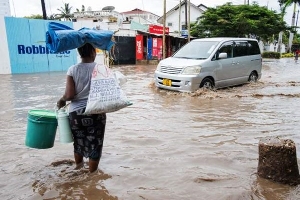- Home - News
- TWI News | TV
- Polls
- Year In Review
- News Archive
- Crime & Punishment
- Politics
- Regional
- Editorial
- Health
- Ghanaians Abroad
- Tabloid
- Africa
- Religion
- Election 2020
- Coronavirus
- News Videos | TV
- Photo Archives
- News Headlines
- Press Release
Opinions of Thursday, 11 June 2020
Columnist: Ing. Dr Patrick Aaniamenga Bowan, PhD, PE-GhIE
Rains and floods in Ghana: Precious lives should not be lost
The rains are here again with its attendant floods. The occurrence and impact of floods can be controlled/mitigated but not completely avoided, as floods only occur when surface runoff is higher than infiltration. Floods are natural and seasonal phenomena that play an important environmental role.
However, human settlements interfere with flood patterns, increasing their magnitude and frequency of occurrence, and aggravating the associated level of risk regarding people, buildings, and economic activities.
Urban floods range from localised micro-drainage problems to major inundation of large portions of cities when both micro and macro-drainage fail to accomplish their basic functions (Daminabo and Enwin, 2015). These problems can lead to material losses to buildings and their contents, damage to urban infrastructure, people relocation, increased risk of diseases, deterioration of water quality, and loss of lives, among others.
When rainfall occurs a portion of the total precipitation is intercepted by a vegetal canopy or retained at surface depressions, another part infiltrates and the rest of it flows superficially over the terrain, conveying to channels and lower areas. The main modification introduced by the urbanisation process to the water budget refers to an increase in superficial runoff production, which often leads to flooding (Xu et al., 2020).
Flood control concepts are evolving continuously, accompanying historical demands of urbanisation and its consequences. Urbanisation changes landscape patterns, aggravating floods by increasing surface runoff flows. In this way, floods become greater in magnitude and time of permanence, occurring even more frequently.
The traditional approach to solving this problem has always focused on the drainage net itself, arranging channels and pipes in an artificial flow net system, with the objective to convey the exceeding waters away from the interest sites. Thus, effective canalisation can deal with floods in a certain area, transferring waters downstream with no major consequences. As time passes, urbanisation grows and more areas of the watershed turn impervious.
The mitigation solution to the impacts of floods in such a scenario should focus on the effective implementation of intensive structural flood control measures, which should involve the main drainage net modifications, including river canalisation and rectification, drains construction, re-engineering and dredging of old canals, among others.
However, due to the high cost involved in the implementation of structural flood control measures and the competing demand for limited resources in Ghana, structural flood control measures are rarely properly implemented, and hence the resulting devastation caused by flood with the least rain in most urban areas.
In contrast to structural flood control measures, are the non-structural measures for flood control. Unlike structural works, that physically act on the flood phenomena, nonstructural measures aim to reduce the exposure of lives and properties to flooding. Examples of non-structural measures for flood control include floodplain management and regulation, master planning, flood forecasting and warning, and flood proofing, among others. These are usually achieved through effective urban planning and zoning, and flood proofing of constructions.
As stated earlier, the havoc caused by floods is getting worst in most urban areas in Ghana due to uncontrolled urbanisation with its attendant challenges, particularly buildings design and mode of construction. Virtually all buildings owners/developers now prefer hard landscaping (concrete flooring or landscaping their yards using pavement/engineering blocks) to soft landscaping, usually to improve the aesthetics of their surroundings, which increases surface runoff and eventually leads to flooding.
Also, most urban dwellers have replaced tree planting, which provided shade in their yards/homes with the erection of summer-huts; hitherto, tree leaves had acted as canopies that reduced the intensity of rain and floods. These coupled with the hard-finished surfacing of roads and public spaces are further exacerbating the problems of flooding in Ghana.
Flooding occurs everywhere in the world; nevertheless, the impact of flooding varies from place to place, depending on the measures put in place to mitigate the impacts of floods. For instance, London and Heathrow Airport in the UK flood with the least rain; however, the flooding is always properly controlled through flood control measures.
Therefore, the solution to the perennial floods in Ghana, which often lead to loss of lives, depends on the effective implementation of structural and non-structural flood control measures. This calls for a concerted effort of all players in the built environment, particularly Architects, Engineers, Planners, Environmentalists, etc.; and their Institutions (Ghana Institute of Architects, Ghana Institution of Engineering, Ghana Institution of Planners, Ghana Institution of Surveyors, etc.) in the design and construction of buildings and other structural works.
Notwithstanding the role of these players, Government and its Agencies (NADMO, EPA and the various Metropolitan, Municipal, and District Assemblies) have the greater responsibility of protecting lives and property, and should provide the needed resources for the implementation of the essential structural and some non-structural flood control measures to avoid the havoc of floods.
Besides, Civil/Public Servants and other technocrats in these agencies should be given the free-hand, devoid of political interference, to enforce the laws, policies and regulations governing the built environment, especially the strict enforcement of the National Building Regulations 1996, (LI 1630) and the newly launched Ghana Building Code, and ensure their compliance.
Already the media has reported of deaths caused by floods in Accra and other parts of the country this year. Meanwhile, the Bagre Dam in Burkina Faso, which causes the flooding of most parts in Northern Ghana along the Black Volta River, is yet to be spilled. The 5th Anniversary of the June 3rd Flood and Fire Disaster in Accra, which claimed over 200 lives has been commemorated, with many surviving victims still wallowing in distress and abject poverty. Should Ghana continue to lose precious lives and properties needlessly to floods in this 21st century?
References
Daminabo, F. O. and Enwin, A. D. (2015) ‘Climate Change and the Increasing Risk of Flooding in the Built Environment’, Journal of Environmental Sciences and Resources Management, 7(1), 30 - 39
Xu, C., Rahman, M., Haase, D., Wu, Y., Su, M. and Pauleit, S. (2020) ‘Surface runoff in urban areas: The role of residential cover and urban growth form’, Journal of Cleaner Production. Elsevier Ltd, 262, 121421. doi: 10.1016/j.jclepro.2020.121421.











